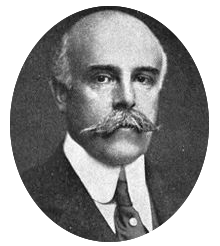
Madison
Grant and his Eugenics

マディソン・グラント(Madison Grant, 1865年11月19日 - 1937年5月30日)は、アメリカの法律家、人類学者、作家、動物学者であり、主に優生学、自然保護論者、科学的人種主義の提唱者として、進歩的時代の 主要思想家・活動家の一人として知られている。優生学研究者としては、科学的人種主義を唱えた"The Passing of the Great Race"(1916)の著者であり、米国における強力な移民制限法と反混血法の制定、「白人の人種的衰退陰謀論/白人虐殺陰謀論」(White genocide conspiracy theory)[David Lane (white supremacist), 1938-2007]の初期の展開に積極的な役割を担った。自然保護活動家としては、多くの動物種の保護、環境保護団体や慈善団体の設立、野生動物管理の 学問の発展などに貢献したことで知られる(英語:Wikipedia, Madison Grant)。
以下の情報もウィキペディア(英語)からのインポートである。翻訳は、www.DeepL.com/Translator(無 料版)による(→「アメリカ合衆国の優生学」)。
| Madison Grant
(November 19, 1865 – May 30, 1937) was an American lawyer, zoologist,
anthropologist, and writer known for his work as a conservationist,
eugenicist, and advocate of scientific racism. Grant is less noted for
his far-reaching achievements in conservation than for his
pseudoscientific advocacy of Nordicism, a form of racism which views
the "Nordic race" as superior.[1][2] As a white supremacist eugenicist, Grant was the author of The Passing of the Great Race (1916), one of the most famous racist texts, and played an active role in crafting immigration restriction and anti-miscegenation laws in the United States.[3][4] As a conservationist, he is credited with the saving of species including the American bison,[5] helped create the Bronx Zoo, Glacier National Park, and Denali National Park, and co-founded the Save the Redwoods League.[6] Grant developed much of the discipline of wildlife management.[7] |
マディソン・グラント(1865年11月19日 -
1937年5月30日)は、アメリカの弁護士、動物学者、人類学者、作家であり、自然保護論者、優生学者、科学的人種差別論者として知られている。グラン
トは、自然保護における広範囲にわたる功績よりも、疑似科学的な「北欧人至上主義」の提唱者として知られている。「北欧人種」を優れているとする人種差別
主義の一形態である。[1][2] 白人至上主義の優生学者として、グラントは最も有名な人種差別主義の文献のひとつ『偉大なる人種の衰退』(1916年)の著者であり、米国における移民制 限法や反混血法の制定に積極的に関与した。自然保護論者としては、アメリカバイソンなどの種の保存に貢献したと評価されており[5]、ブロンクス動物園、 グレイシャー国立公園、デナリ国立公園の設立に協力し、セーブ・ザ・レッドウッド・リーグの共同設立者でもある。グラントは野生動物管理の分野を大きく発 展させた。[7] |
★マディソン・グラント(Madison Grant, 1865年11月19日 - 1937年5月30日)
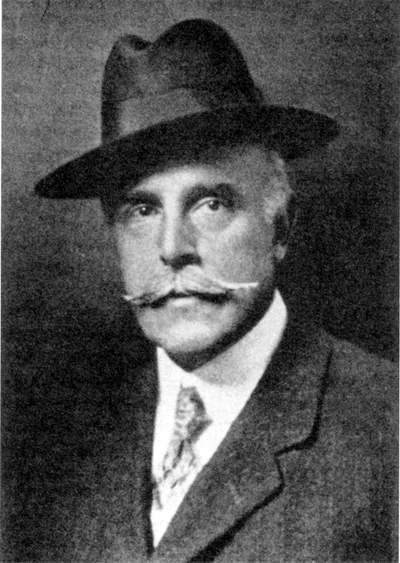 Grant was born
in
New York City, New York, the son of Gabriel Grant, a physician and
American Civil War surgeon, and Caroline Manice. Madison Grant's mother
was a descendant of Jessé de Forest, the Walloon Huguenot who in 1623
recruited the first band of colonists to settle in New Netherland, the
Dutch Republic's territory on the American East Coast. On his father's
side, Madison Grant's first American ancestor was Richard Treat, dean
of Pitminster Church in England, who in 1630 was one of the first
Puritan settlers of New England. Grant's forebears through Treat's line
include Robert Treat (a colonial governor of New Jersey), Robert Treat
Paine (a signer of the Declaration of Independence), Charles Grant
(Madison Grant's grandfather, who served as an officer in the War of
1812), and Gabriel Grant (father of Madison), a prominent physician and
the health commissioner of Newark, New Jersey.[1] Dr. Gabriel Grant was
awarded the Medal of Honor while serving as surgeon with the 2nd New
Jersey Volunteers in the Civil War.[2] During the Battle of Fair Oaks,
he moved the wounded to safety while under heavy fire.[3] Grant was a
lifelong resident of New York City. Grant was the oldest of four
siblings. The children's summers, and many of their weekends, were
spent at Oatlands, the Long Island country estate built by their
grandfather DeForest Manice in the 1830s.[4] As a child, he attended
private schools and traveled Europe and the Middle East with his
father. He attended Yale University, graduating early and with honors
in 1887. He received a law degree from Columbia Law School, and
practiced law after graduation; however, his interests were primarily
those of a naturalist. He never married and had no children. He first
achieved a political reputation when he and his brother, De Forest
Grant, took part in the 1894 electoral campaign of New York mayor
William Lafayette Strong. Grant was born
in
New York City, New York, the son of Gabriel Grant, a physician and
American Civil War surgeon, and Caroline Manice. Madison Grant's mother
was a descendant of Jessé de Forest, the Walloon Huguenot who in 1623
recruited the first band of colonists to settle in New Netherland, the
Dutch Republic's territory on the American East Coast. On his father's
side, Madison Grant's first American ancestor was Richard Treat, dean
of Pitminster Church in England, who in 1630 was one of the first
Puritan settlers of New England. Grant's forebears through Treat's line
include Robert Treat (a colonial governor of New Jersey), Robert Treat
Paine (a signer of the Declaration of Independence), Charles Grant
(Madison Grant's grandfather, who served as an officer in the War of
1812), and Gabriel Grant (father of Madison), a prominent physician and
the health commissioner of Newark, New Jersey.[1] Dr. Gabriel Grant was
awarded the Medal of Honor while serving as surgeon with the 2nd New
Jersey Volunteers in the Civil War.[2] During the Battle of Fair Oaks,
he moved the wounded to safety while under heavy fire.[3] Grant was a
lifelong resident of New York City. Grant was the oldest of four
siblings. The children's summers, and many of their weekends, were
spent at Oatlands, the Long Island country estate built by their
grandfather DeForest Manice in the 1830s.[4] As a child, he attended
private schools and traveled Europe and the Middle East with his
father. He attended Yale University, graduating early and with honors
in 1887. He received a law degree from Columbia Law School, and
practiced law after graduation; however, his interests were primarily
those of a naturalist. He never married and had no children. He first
achieved a political reputation when he and his brother, De Forest
Grant, took part in the 1894 electoral campaign of New York mayor
William Lafayette Strong. |
 グラントは、医師でアメリカ南北戦争の外科医であったガブリエ
ル・グラ
ントとキャロライン・マニスの息子としてニューヨーク市に誕生した。マディソン・グラントの母親は、1623年にアメリカ東海岸にあったオランダ共和国領
ニューネザーランドに最初の植民者の一団を募集したワロン系ユグノー、ジェセ・ド・フォレストの子孫であった。父方の祖先は、イギリスのピットミンスター
教会の学長リチャード・トリートで、1630年にニューイングランドに入植した最初の清教徒の一人である。トリート家の先祖には、ロバート・トリート
(ニュージャージー州の植民地総督)、ロバート・トリート・ペイン(独立宣言の署名者)、チャールズ・グラント(マディソン・グラントの祖父、1812年
の戦争で将校として活躍)、著名な医師でニュージャージー州ニューアークの保健政策顧問だったガブリエル・グラント(マディソンの父)らがいる[1]。
[1] 医師ガブリエル・グラントは南北戦争で第2ニュージャージー義勇軍の外科医として従軍中に名誉勲章を授与された[2]
フェアオークの戦いでは、激しい銃撃を受けながら負傷者を安全な場所に運んだ[3]
グラントは生涯ニューヨークの住人であった。グラントは4人兄弟の長男であった。子供たちの夏と週末の多くは、祖父のデフォレスト・マニスが1830年代
に建てたロングアイランドの田舎の屋敷、オートランズで過ごした[4]。幼少期は私立学校に通い、父親とヨーロッパと中東を旅行した。1887年、エール
大学を優秀な成績で卒業。コロンビア大学法科大学院で法学博士号を取得し、卒業後は弁護士として活動したが、彼の関心は主に自然主義者のそれであった。結
婚もせず、子供もいない。1894年、ニューヨーク市長のウィリアム・ラファイエット・ストロングの選挙キャンペーンに、弟のデ・フォレスト・グラントと
ともに参加し、初めて政治家としての評価を得た。 グラントは、医師でアメリカ南北戦争の外科医であったガブリエ
ル・グラ
ントとキャロライン・マニスの息子としてニューヨーク市に誕生した。マディソン・グラントの母親は、1623年にアメリカ東海岸にあったオランダ共和国領
ニューネザーランドに最初の植民者の一団を募集したワロン系ユグノー、ジェセ・ド・フォレストの子孫であった。父方の祖先は、イギリスのピットミンスター
教会の学長リチャード・トリートで、1630年にニューイングランドに入植した最初の清教徒の一人である。トリート家の先祖には、ロバート・トリート
(ニュージャージー州の植民地総督)、ロバート・トリート・ペイン(独立宣言の署名者)、チャールズ・グラント(マディソン・グラントの祖父、1812年
の戦争で将校として活躍)、著名な医師でニュージャージー州ニューアークの保健政策顧問だったガブリエル・グラント(マディソンの父)らがいる[1]。
[1] 医師ガブリエル・グラントは南北戦争で第2ニュージャージー義勇軍の外科医として従軍中に名誉勲章を授与された[2]
フェアオークの戦いでは、激しい銃撃を受けながら負傷者を安全な場所に運んだ[3]
グラントは生涯ニューヨークの住人であった。グラントは4人兄弟の長男であった。子供たちの夏と週末の多くは、祖父のデフォレスト・マニスが1830年代
に建てたロングアイランドの田舎の屋敷、オートランズで過ごした[4]。幼少期は私立学校に通い、父親とヨーロッパと中東を旅行した。1887年、エール
大学を優秀な成績で卒業。コロンビア大学法科大学院で法学博士号を取得し、卒業後は弁護士として活動したが、彼の関心は主に自然主義者のそれであった。結
婚もせず、子供もいない。1894年、ニューヨーク市長のウィリアム・ラファイエット・ストロングの選挙キャンペーンに、弟のデ・フォレスト・グラントと
ともに参加し、初めて政治家としての評価を得た。 |
| Grant was a close friend of
several U.S. presidents, including Theodore Roosevelt and Herbert
Hoover, and also was an avid conservationist. He is credited with
saving many natural species from extinction, and co-founded the Save
the Redwoods League with Frederick Russell Burnham, John C. Merriam,
and Henry Fairfield Osborn in 1918. He is also credited with helping
develop the first deer hunting laws in New York state, legislation
which spread to other states as well over time. [photograph: Ota Benga
was exhibited in the Monkey House of the Bronx Zoo, New York in 1906.]
He was also the creator of wildlife management; helped to found
the Bronx Zoo, build the Bronx River Parkway, save the American bison
as an organizer of the American Bison Society, and helped to create
Glacier National Park and Denali National Park. In 1906, as Secretary
of the New York Zoological Society, he lobbied to put Ota Benga, a
Congolese man from the Mbuti people (a tribe of "pygmies"), on display
alongside apes at the Bronx Zoo.[5] Throughout the 1920s and 1930s, he
served on the boards of many eugenic and philanthropic societies,
including the board of trustees at the American Museum of Natural
History, as director of the American Eugenics Society, vice president
of the Immigration Restriction League, a founding member of the Galton
Society, and one of the eight members of the International Committee of
Eugenics. He was awarded the gold medal of the Society of Arts and
Sciences in 1929. In 1931, the world's largest tree (in Dyerville,
California) was dedicated to Grant, Merriam, and Osborn by the
California State Board of Parks in recognition for their environmental
efforts. A subspecies of caribou was named after Grant as well (Rangifer tarandus granti,
also known as Grant's Caribou). He was a member of the Boone and
Crockett Club (a big game hunting organization) since 1893, where he
was friends with president Theodore Roosevelt. He was head of the New
York Zoological Society from 1925 until his death. Historian Jonathan
Spiro has argued that Grant's interests in conservationism and eugenics
were not unrelated: both are hallmarks of the early 20th-century
Progressive movement, and both assume the need for various types of
stewardship over their charges.[6] In Grant's mind, natural resources
needed to be conserved for the Nordic Race, to the exclusion of other
races. Grant viewed the Nordic race lovingly as he did any of his
endangered species, and considered the modern industrial society as
infringing just as much on its existence as it did on the redwoods.
Like many eugenicists, Grant saw modern civilization as a violation of
"survival of the fittest", whether it manifested itself in the
over-logging of the forests, or the survival of the poor via welfare or
charity.[In this section, verification is needed] |
グラントは、セオドア・ルーズベルトやハーバート・フーバーなど、複数
のアメリカ大統領と親交があり、また熱心な自然保護論者でもあった。
1918年、フレデリック・ラッセル・バーナム、ジョン・C・メリアム、ヘンリー・フェアフィールド・オズボーンとともに「セーブ・ザ・レッドウッズ・
リーグ」を設立し、多くの自然生物を絶滅の危機から救ったとされる。また、ニューヨーク州で初めて鹿の狩猟に関する法律を制定したことでも知られ、この法
律はやがて他の州にも広がっていった。写真
[写真:1906年、ニューヨークのブロンクス動物園のサル舎に展示されたオタ・ベンガ]。また、ブロンクス動物園の設立、ブロンクス川パークウェイの建
設、アメリカバイソン協会の組織者としてアメリカバイソンの保護、グレーシャー国立公園とデナリ国立公園の設立に貢献し、野生動物管理の生みの親となっ
た。1906年、ニューヨーク動物園協会の長官として、コンゴのムブティ族(ピグミー)のオタ・ベンガをブロンクス動物園に猿と一緒に展示するよう働きか
けを行った[5]。
1920年代から1930年代にかけて、アメリカ自然史博物館の理事、アメリカ優生学会の理事、移民制限連盟の副会長、ゴルトン協会の創立メンバー、優生
学国際委員会のメンバー8人の1人など、多くの優生学・博愛主義団体の役員を歴任した[5]。1929年、芸術科学協会より金メダル授与。1931年、カ
リフォルニア州公園委員会により、環境保護への取り組みが認められ、世界最大の木(カリフォルニア州ダイアビル)がグラント、メリアム、オズボーンに捧げ
られた。カリブーの亜種にもグラントの名前が付けられた(Grant's Caribouとも呼ばれるRangifer tarandus granti[学
名])。1893年からブーン・アンド・クロケット・クラブ(大物狩猟団体)の会員となり、セオドア・ルーズベルト大統領と親交を深めた。1925年から
亡くなるまで、ニューヨーク動物園協会の代表を務めた。歴史家のジョナサン・スピロは、グラントの自然保護主義と優生学への関心は無関係ではないと論じて
いる。どちらも20世紀初頭の進歩主義運動の特徴であり、その対象に対してさまざまな種類のスチュワードシップ(=奉仕の精神)の必要性を想定している
[6] グラントの考えでは、天然資源は他の人種を排除して北欧人種のために保存さ
れる必要があった。グラントは北欧人種を絶滅危惧種と同じように愛情
をもって見ており、現代の産業社会が(原生林の)レッドウッドと同じようにその存在を侵害されていると考えていたのである。多くの優生学者
がそうであるように、グラントも現代文明が「適者生存」のメカニズムを阻害していると
考えた。それが森林の過剰伐採であれ、福祉や慈善事業による貧困層の救済であれ、である。【このセクションの内容は検証が必要である】。 |
| Nordic theory (Nordic race) |
北方人種理論(=北欧人種優位説) |
 Grant was the author of the once much-read book The Passing of the Great Race[7] (1916), an elaborate work of racial hygiene attempting to explain the racial history of Europe. The most significant of Grant's concerns was with the changing "stock" of American immigration of the early 20th century (characterized by increased numbers of immigrants from Southern and Eastern Europe, as opposed to Western and Northern Europe), Passing of the Great Race was a "racial" interpretation of contemporary anthropology and history, stating race as the basic motor of civilization. Similar ideas were proposed by prehistorian Gustav Kossinna in Germany. Grant promoted the idea of the "Nordic race",[8] a loosely defined biological-cultural grouping rooted in Scandinavia, as the key social group responsible for human development; thus the subtitle of the book was The racial basis of European history. As an avid eugenicist, Grant further advocated the separation, quarantine, and eventual collapse of "undesirable" traits and "worthless race types" from the human gene pool and the promotion, spread, and eventual restoration of desirable traits and "worthwhile race types" conducive to Nordic society: |
 グラントは、かつて多くの読者を得た『偉大なる人種の通過(The Passing of the Great Race)』 [7] (1916年)の著者であり、ヨーロッパの人種史を説明しようとする人種衛生(racial hygiene)の精巧な仕事であった。グラントの最も大きな関心は、20世紀初頭のアメリカ移民の「ストック」の変化(西欧や北欧とは対照的に、南欧や 東欧からの移民が増えたことが特徴)であり、『偉大なる人種の通過』は現代の人類学と歴史学を「人種的」に解釈し、人種が文明の基本推進機であると述べて いる。同じような考え方は、ドイツの先史学者グスタフ・コシンナも提唱していた。グラントは、スカンジナビアに根ざした緩やかな生物学的・文化的集団であ る「北欧人種」[8]を、人類の発展を担う重要な社会集団と位置づけ、『ヨーロッパ史の人種的基礎』という副題を付けた。さらに、グラントは熱心な優生学 者として、人間の遺伝子プールから「望ましくない」形質と「価値のない人種タイプ」を分離、隔離、崩壊させ、北欧社会に資する望ましい形質と「価値のある 人種タイプ」を促進、普及、回復させることを提唱した。 |
|
Citation ; "A rigid system of
selection through the elimination of those who are weak or unfit—in
other words social failures—would solve the whole question in one
hundred years, as well as enable us to get rid of the undesirables who
crowd our jails, hospitals, and insane asylums. The individual himself
can be nourished, educated and protected by the community during his
lifetime, but the state through sterilization must see to it that his
line stops with him, or else future generations will be cursed with an
ever increasing load of misguided sentimentalism. This is a practical,
merciful, and inevitable solution of the whole problem, and can be
applied to an ever widening circle of social discards, beginning always
with the criminal, the diseased, and the insane, and extending
gradually to types which may be called weaklings rather than
defectives, and perhaps ultimately to worthless race types.[9]"
|
【引用】「弱
者や不適格者、つまり社会的落伍者を排除する厳格な選別システムは、100年以内にこの問題全体を解決するだろうし、刑務所や病院、精神病院を賑わす不適
格者を排除することも可能になるはずだ。しかし、国家は、不妊手術によって、彼の血筋が彼で止まるようにしなければならない。そうしなければ、将来の世代
は、誤った感傷主義の負荷がますます大きくなる呪いを受けることになる。これは、問題全体に対する実際的で、慈悲深く、必然的な解決策であり、常に犯罪
者、病人、精神異常者から始まり、欠陥者ではなく弱者と呼ばれるタイプに徐々に拡大し、おそらく最終的には価値のない人種タイプにまで拡大する、社会廃棄
物の輪がますます広がることに適用可能である[9]。」
|
| In the book, Grant recommends
segregating "unfavorable" races in ghettos, by installing civil
organizations through the public health system to establish
quasi-dictatorships in their particular fields.[10] He states the
expansion of non-Nordic race types in the Nordic system of freedom
would actually mean a slavery to desires, passions, and base behaviors.
In turn, this corruption of society would lead to the subjection of the
Nordic community to "inferior" races, who would in turn long to be
dominated and instructed by "superior" ones utilizing authoritarian
powers. The result would be the submergence of the indigenous Nordic
races under a corrupt and enfeebled system dominated by inferior races,
and both in turn would be subjected by a new ruling race class. Nordic
theory, in Grant's formulation, was similar to many 19th-century racial
philosophies, which divided the human species into primarily three
distinct races: Caucasoids (based in Europe - Whites), Negroids (based
in Africa - Blacks), and Mongoloids (based in Asia - Asians). Nordic
theory, however, further subdivided Caucasoids (Whites) into three
groups: Nordics (who inhabited Northern Europe and other parts of the
continent), Alpines (whose territory included central Europe and parts
of Asia), and Mediterraneans (who inhabited Southern Europe, North
Africa, parts of Ireland and Wales, and the Middle East). In Grant's
view, Nordics probably evolved in a climate that "must have been such
as to impose a rigid elimination of defectives through the agency of
hard winters and the necessity of industry and foresight in providing
the year's food, clothing, and shelter during the short summer. Such
demands on energy, if long continued, would produce a strong, virile,
and self-contained race which would inevitably overwhelm in battle
nations whose weaker elements had not been purged by the conditions of
an equally severe environment."[11] The "Proto-Nordic" human, Grant
reasoned, probably evolved in eastern Germany, Poland and Russia,
before migrating northward to Scandinavia. The Nordic, in his theory,
was Homo europaeus, the white man par excellence. "It is everywhere
characterized by certain unique specializations, namely, wavy brown or
blond hair and blue, gray or light brown eyes, fair skin, high, narrow
and straight nose, which are associated with great stature, and a long
skull, as well as with abundant head and body hair."[12] Grant
categorized the Alpines as being the lowest of the three European
races, with the Nordics as the pinnacle of civilization. |
この本の中で、グラントは「好ましくない」人種をゲットーに隔離し、公
衆衛生システムを通じて市民組織を設置し、特定の分野で準独裁を確立することを推奨している[10]。
彼は、北欧の自由なシステムの中で非北欧の人種タイプが拡大することは、実際には欲望、情熱、卑しい行動への奴隷になることを意味すると述べている。そし
て、この社会の腐敗は、北欧の共同体を「劣等」人種に従属させ、劣等人種は権威主義的な力を利用した「優等」人種による支配と指導に憧れるようになる。そ
の結果、北欧の土着民族は劣等民族の支配する腐敗した弱体化したシステムの下に沈められ、両者は新たな支配民族によって服従させられることになるのであ
る。グラントが提唱したノルディック理論は、19世紀の多くの人種思想と同じで、人類を主に3つの人種に分類していた。白人(コーカソイド)、黒人(ニグ
ロイド)、モンゴロイド(アジア人)である。しかし、ノルディック理論は、コーカソイド(白人)をさらに3つのグループに細分化した。ノルディック(北欧
を中心とした大陸)、アルプス(中央ヨーロッパとアジアの一部を含む)、地中海(南ヨーロッパ、北アフリカ、アイルランドとウェールズの一部、中東)に住
む人々である。グラント氏の考えでは、北欧人はおそらく「厳しい冬を過ごすことで欠点を徹底的に排除し、短い夏にその年の衣食住をまかなうために産業と先
見性を必要とするような気候の中で進化してきたに違いない」。このような(情熱の)エネルギーへの要求は、長く続けば、強く、男らしく、自己完結した種族
を生み出し、同じように厳しい環境の条件によって弱い要素が浄化されなかった国々の戦いで必然的に圧倒されるだろう」[11]。グラント氏は、「原-北
方」人はおそらく東ドイツ、ポーランド、ロシアで進化し、北欧に移動したのではないかと推論した。北欧人とは、ホモ・エウロペウス(Homo
europaeus)のことであり、白人のことである。「すなわち、ウェーブのかかった茶色またはブロンドの髪、青、灰色または薄茶の目、白い肌、高く、
狭く、まっすぐな鼻、これらは大きな身長、長い頭蓋骨、および豊富な頭髪と関連している」[12]
グラントは、アルプス人をヨーロッパ3人種のうちの最低ランクとし、北欧人を文明の頂点と分類していた。 |
|
The Nordics are, all over the
world, a race of soldiers, sailors, adventurers, and explorers, but
above all, of rulers, organizers, and aristocrats in sharp contrast to
the essentially peasant character of the Alpines. Chivalry and
knighthood, and their still surviving but greatly impaired
counterparts, are peculiarly Nordic traits, and feudalism, class
distinctions, and race pride among Europeans are traceable for the most
part to the north.[13]
|
北欧の人々は、世界中で兵士、船乗り、冒険家、探検家であり、とりわけ支
配者、組織者、貴族の人種であり、アルプスの人々の本質的な農民的性格とは対照的である。騎士道と騎士団、および現在も存続しているが大きく損なわれてい
るそれに相当するものは、北欧特有の特徴であり、ヨーロッパ人の封建制、階級差別、人種的プライドは、そのほとんどが北欧に起因するものである[13]。
|
| Grant, while aware of the
"Nordic migration theory" into the Mediterranean, appears to reject
this theory as an explanation for the high civilization features of the
Greco-Roman world. |
グラントは、地中海への「北欧人移住説」を意識しながらも、古代ギリ
シャ=ローマ世界の高度な文明の特徴を説明するものとして、この説を否定しているようである。(→「日独伊三国同盟間における人種的不信感」や後の「ブ
ラック・アテネ」への反発に通底) |
|
The mental characteristics of the
Mediterranean race are well known, and this race, while inferior in
bodily stamina to both the Nordic and the Alpine, is probably the
superior of both, certainly of the Alpines, in intellectual
attainments. In the field of art its superiority to both the other
European races is unquestioned.[13]
|
地中海人種の精神的特徴はよく知られているが、この人種は、肉体的なスタ
ミナでは北欧人とアルプス人に劣るものの、知的な到達点ではおそらく両人、特にアルプス人に勝っている。芸術の分野では、他のヨーロッパの両民族に対する
優越性は疑う余地がない[13]。
|
| Grant also considered North
Africa as part of Mediterranean Europe: |
グラントも北アフリカを地中海ヨーロッパの一部と見なしていた。 |
|
Africa north of the Sahara, from
a zoological point of view, is now, and has been since early Tertiary
times, a part of Europe. This is true both of animals and of the races
of man. The Berbers of north Africa to-day are racially identical with
the Spaniards and south Italians.[14]
|
サハラ以北のアフリカは、動物学的に見れば、現在も、そして第三紀初頭か
らずっと、ヨーロッパの一部であった。これは動物についても、人間の種族についても言えることである。今日、北アフリカのベルベル人は、人種的にはスペイ
ン人や南イタリア人と同じである[14]。
|
| Yet while Grant recognized
Mediterraneans to have abilities in art, as quoted above, later in the
text, he pondered if the Mediterranean achievements in civilization
were due to Nordic original ideals and structure: |
しかし、グラントは、上記のように地中海人の芸術的能力を認めながら
も、テキストの後半で、地中海の文明の成果は、北欧独自の理想と構造によるものではないか、と考えている。 |
|
This is the race that gave the
world the great civilizations of Egypt, of Crete, of Phoenicia
including Carthage, of Etruria and of Mycenaean Greece. It gave us,
when mixed and invigorated with Nordic elements, the most splendid of
all civilizations, that of ancient Hellas, and the most enduring of
political organizations, the Roman State. To what extent the
Mediterranean race entered into the blood and civilization of Rome, it
is now difficult to say, but the traditions of the Eternal City, its
love of organization, of law and military efficiency, as well as the
Roman ideals of family life, loyalty, and truth, point clearly to a
Nordic rather than to a Mediterranean origin.[15]
|
この人種は、エジプト、クレタ島、カルタゴを含むフェニキア、エトルリ
ア、ミケーネ・ギリシャの偉大な文明を世界にもたらしたのである。北欧の要素と混じり合って活性化されたとき、あらゆる文明の中で最も素晴らしい古代ギリ
シャ文明(ancient
Hellas)と、最も永続的な政治組織であるローマ国家をもたらした。地中海人種がローマの血と文明にどの程度まで入り込んだかは、現在では指摘が難し
いが、永遠の都の伝統、組織、法律、軍事的効率に対する愛、家族生活、忠誠、真実といったローマの理想は、明らかに地中海起源ではなく、北欧起源であるこ
とを指し示している[15]。
|
| According to Grant, Nordics were
in a dire state in the modern world, where, because of their
abandonment of cultural values, rooted in religious or superstitious
proto-racialism, they were close to committing "race suicide" by
miscegenation and by being outbred by inferior stock taking advantage
of the situation. |
グラントによれば、北欧人は、宗教的あるいは迷信的な原-人種主義に根
ざした文化的価値を放棄したために、近代の世界では、混血や劣等種が状況を利用して異種交配することによって「人種の自殺」に近い状態にあったという。 |
| This is the race that gave the
world the great civilizations of Egypt, of Crete, of Phoenicia
including Carthage, of Etruria and of Mycenaean Greece. It gave us,
when mixed and invigorated with Nordic elements, the most splendid of
all civilizations, that of ancient Hellas, and the most enduring of
political organizations, the Roman State. To what extent the
Mediterranean race entered into the blood and civilization of Rome, it
is now difficult to say, but the traditions of the Eternal City, its
love of organization, of law and military efficiency, as well as the
Roman ideals of family life, loyalty, and truth, point clearly to a
Nordic rather than to a Mediterranean origin.[15] |
この本は、アメリカで何度も増刷され、1925年にはドイツ語など他の
言語にも翻訳された。1937年にはアメリカ国内だけで1万6千部を売り上げた。北方理論は、1920年代初頭から1930年代にかけて、ドイツの人種衛
生運動で強く受け入れられていた。ただし、その際、彼らは通常「北欧」ではなく「アー
リア人」という言葉を使ったが、ナチの主要思想家アルフレッド・ローゼンベルクは「アーリオ-ノルド人(Aryo-Nordic)」あるい
は「北欧-アトランティス人」を好んで使った。 |
| Stephen Jay Gould described The
Passing of the Great Race as "the most influential tract of American
scientific racism".[16] Grant's work was embraced by proponents of the
National Socialist movement in Germany and was the first non-German
book ordered to be reprinted by the Nazis when they took power. Adolf
Hitler wrote to Grant, "The book is my Bible."[6][17] |
スティーブン・ジェイ・グールドは『偉大なる人種の通過』を「アメリカ
の科学的人種差別の最も影響力のある小冊子」と評した[16]。グラントの作品はドイツの国家社会主義運動(ナチス)の支持者によって受け入れられ、ナチ
スが政権を取ったとき、ドイツ以外の本で最初に再版を命じられたものである。アドルフ・ヒトラーはグラントに対して「この本は私の聖書だ」と書き送ってい
る[6][17]。 |
| Grant's work is considered one
of the most influential and vociferous works of scientific racism and
eugenics to come out of the United States. One of his long-time
opponents was the anthropologist Franz Boas. Grant disliked Boas and
for several years tried to get him fired from his position at Columbia
University.[18][19] Boas and Grant were involved in a bitter struggle
for control over the discipline of anthropology in the United States,
while they both served (along with others) on the National Research
Council Committee on Anthropology after the First World War. |
グラントの研究は、アメリカから生まれた科学的人種差別と優生学に関す
る最も影響力のある、声高な著作のひとつと考えられている。彼の長年の敵対者のひとりが人類学者のフランツ・ボアズである。グラントはボアズを嫌い、数年にわたりコロンビア大学の職を
解かせようとした。ボアズとグラントは、第一次世界大戦後、人類学に関する国家研究会議委員会の委員を務めながら、アメリカにおける人類学の支配権をめぐ
る激しい争いに巻き込まれた。 |
| Grant represented the
"hereditarian" branch of physical anthropology at the time, despite his
relatively amateur status, and was staunchly opposed to and by Boas
himself (and the latter's students), who advocated cultural
anthropology. Boas and his students eventually wrested control of the
American Anthropological Association from Grant and his supporters, who
had used it as a flagship organization for his brand of anthropology.
In response, Grant, along with American eugenicist and biologist
Charles B. Davenport, in 1918 founded the Galton Society as an
alternative to Boas.[20] |
グラントは、その立場において比較的アマチュアであったにもかかわら
ず、当時の自然人類学の「遺伝学派」の一派を代表し、文化人類学を標榜するボアズ自身(とボアズの弟子)とは断固として対立していたのである。ボアスとそ
の弟子たちは、やがてアメリカ人類学会(AAA)を自らの人類学の旗印とするグラントとその支持者たちから、その主導権を奪い取ることになる。これに対し
て、グラントは、アメリカの優生学者で生物学者のチャールズ・B・ダベンポート(Charles B.
Davenport)とともに、1918年にボアズに代わる存在として、ゴルトン協会(Galton Society)を設立する[20]。 |
| Grant advocated restricted
immigration to the United States through limiting immigration from
Eastern Europe and Southern Europe, as well as the complete end of
immigration from East Asia. He also advocated efforts to purify the
American population through selective breeding. He served as the vice
president of the Immigration Restriction League from 1922 to his death.
Acting as an expert on world racial data, Grant also provided
statistics for the Immigration Act of 1924 to set the quotas on
immigrants from certain European countries.[21] Even after passing the
statute, Grant continued to be irked that even a smattering of
non-Nordics were allowed to immigrate to the country each year. He also
assisted in the passing and prosecution of several anti-miscegenation
laws, including the Racial Integrity Act of 1924 in the state of
Virginia, where he sought to codify his particular version of the
"one-drop rule" into law. |
グラントは、東欧や南欧からの移民を制限し、東アジアからの移民を完全
に絶つことを提唱した。また、選択育種によるアメリカ人の純化を提唱した。1922年から(1937年に)亡くなるまで、移民制限連盟
(Immigration Restriction
League)の副会長を務めた。また、世界の人種データの専門家として、1924年にヨーロッパ諸国からの移民の割当を定めた移民法に統計を提供した
[21]。
この法律が成立した後も、グラントは毎年、非北欧人がわずかでも移民することに対しては苛立ちを持ち続けた。彼はまた、1924年にバージニア州で制定さ
れた人種統合法(Racial Integrity Act of
Virginia)を含むいくつかの異種族混血禁止法の成立とそれに関連する訴追を支援し、そこで彼は「血の1滴ルール」の特定のバージョンを法律のなか
に盛り込み成文化しようとした。 |
| Though Grant was extremely
influential in legislating his view of racial theory, he began to fall
out of favor in the United States in the early 1930s. The declining
interest in his work has been attributed both to the effects of the
Great Depression, which resulted in a general backlash against Social
Darwinism and related philosophies, and to the changing dynamics of
racial issues in the United States during the interwar period. Rather
than subdivide Europe into separate racial groups, the bi-racial (black
vs. white) theory of Grant's protegé Lothrop Stoddard became more
dominant in the aftermath of the Great Migration of African-Americans
from Southern States to Northern and Western ones (Guterl 2001). |
しかし、1930年代前半になると、グラントに対する影響力は薄れてい
く。その背景には、世界恐慌の影響で社会ダーウィニズムや関連する哲学に対する反発が生じたことと、戦間期におけるアメリカの人種問題の力学が変化したこ
とが挙げられる。グラントの弟子であるロスロップ・ストッダードは、ヨーロッパを人種的に細分化するのではなく、南部諸州から北部や西部諸州へのアフリカ
系アメリカ人の大移動を経て、二つの人種論(黒人対白人)理論を主流化しようとした(Guterl 2001)。 |
| Grant became a part of popular
culture in 1920s America, especially in New York. Grant's
conservationism and fascination with zoological natural history made
him very influential among the New York elite, who agreed with his
cause, most notably Theodore Roosevelt. Author F. Scott Fitzgerald
featured a reference to Grant in The Great Gatsby. Tom Buchanan, a
fatuous Long Island aristocrat married to Daisy, was reading a book
called The Rise of the Colored Empires by "this man Goddard", blending
Grant's Passing of the Great Race and his colleague Lothrop Stoddard's
The Rising Tide of Color Against White World Supremacy.[citation
needed] Grant left no offspring when he died in 1937 of nephritis.
Several hundred people attended Grant's funeral,[6] and he was buried
in Sleepy Hollow Cemetery in Tarrytown, New York. He left a bequest of
$25,000 to the New York Zoological Society to create "The Grant
Endowment Fund for the Protection of Wild Life", $5,000 to the American
Museum of Natural History, and another $5,000 to the Boone and Crockett
Club. |
グラントは、1920年代のアメリカ、特にニューヨークで大衆文化の一
部となった。グラントの自然保護主義と動物学的自然史の魅力は、セオドア・ルーズベルトを筆頭に、彼の主張に賛同したニューヨークのエリートたちに大きな
影響力を与えた。作家のF・スコット・フィッツジェラルドは、『華麗なるギャツビー』の中で、グラントに関する言及をしている。デイジーと結婚したロング
アイランドの太った貴族トム・ブキャナンは、「この男ゴダード」の『有色人種の帝国の台頭』という本を読んでおり、グラントの『偉大なる人種の通過』と彼
の同僚ロスプロップ・ストッダードの『白人世界至上主義に対する有色人種の上昇気流』を混ぜ合わせている[引証が必要]
グラントは1937年に腎臓炎で死んだとき誰の子孫も残さなかった。葬儀には数百人が参列し[6]、ニューヨーク州タリータウンのスリーピー・ホロウ墓地
に埋葬された。ニューヨーク動物園協会に25,000ドル、アメリカ自然史博物館に5,000ドル、ブーン&クロケット・クラブに5,000ドルの遺贈が
あった。 |
| Grant was not only a crusading
environmentalist. He opposed war, had doubts about imperialism, and
strongly supported birth control.[22] |
グラントは、環境保護主義者であっただけではない。彼は戦争に反対し、
帝国主義に疑問を持ち、避妊を強く支持していた[22]。 |
| At the postwar Nuremberg Trials,
three pages of excerpts from Grant's Passing of the Great Race was
introduced into evidence by the defense of Karl Brandt, Hitler's
personal physician and head of the Nazi euthanasia program, in order to
justify the population policies of the Third Reich, or at least
indicate that they were not ideologically unique to Nazi Germany.[23] |
戦後のニュルンベルク裁判では、ヒトラーの専属医でナチスの安楽死プロ
グラムの責任者であったカール・ブラントの弁護側が、第三帝国の人口政策を正当化するた
め、あるいは少なくともそれがナチスドイツに特有の思想的なもので
はないと示すために、グラントの『偉大なる人種の通過』の3ページの抜粋を証拠として提出した[23]。 |
| Grant's works of "scientific
racism" have been cited to demonstrate that many of the genocidal and
eugenic ideas associated with the Third Reich did not arise
specifically in Germany, and in fact that many of them had origins in
other countries, including the United States.[24] As such, because of
Grant's well-connected and influential friends, he is often used to
illustrate the strain of race-based eugenic thinking in the United
States, which had some influence until the Second World War. Because of
the use made of Grant's eugenics work by the policy-makers of Nazi
Germany, his work as a conservationist has been somewhat ignored and
obscured, as many organizations with which he was once associated (such
as the Sierra Club) wanted to minimize their association with him.[6] |
グラントの「科学的人種主義」の著作は、第三帝国に関連する大量虐殺や
優生思想の多くがドイツに特化して生じたものではなく、実際にはアメリカを含む他の国に起源を持つことを示すために引用されている[24]。そのため、グ
ラントの人脈と影響力のある友人により、彼はしばしばアメリカにおける人種ベースの優生思想の流れを示すために用いられ、第二次世界大戦まで一定の影響を
及ぼした。ナチス・ドイツの政策立案者がグラントの優生学的研究を利用したため、かつてグラントが関係していた多くの組織(シエラ・クラブなど)が彼との
関係を最小限にしようとしたため、彼の自然保護主義者としての活動はやや無視され、不明瞭なものとなっている[6]。 |
| On June 15, 2021, California
State Parks removed a memorial to Madison Grant from Prairie Creek
Redwoods State Park placed in the park in 1948. The monument's removal
is part of a broader effort in California Parks to address outdated
exhibits and interpretations related to the founders of Save the
Redwoods. In spring 2022, California State Parks will install a new
interpretive panel, co-written with academic scholars, that tells a
fuller story about Grant, his conservation legacy, and his central role
in the eugenics movement.[25][26] |
2021年6月15日、カリフォルニア州立公園は、1948年に公園に
置かれたプレーリーク・レッドウッズ州立公園のマディソン・グラントの記念碑を撤去した。この記念碑の撤去は、セーブ・ザ・レッドウッズの創設者に関連す
る古くなった展示物や解説に対処するための、カリフォルニア州立公園の幅広い取り組みの一環であった。2022年春、カリフォルニア州立公園は、グラント
とその保護遺産、優生学運動における中心的な役割についてより詳しく語る、学術学者との共同執筆による新しい解説パネルを設置する予定である[25]
[26]。 |
| https://en.wikipedia.org/wiki/Madison_Grant | |
| Madison Grant was a lawyer and
wildlife conservationist who advocated for eugenics policies in the US
during the late nineteenth and early twentieth centuries. In his 1916
book, The Passing of the Great Race; or, The Racial Basis of European
History, Grant argued that what he called the Nordic race, which
originated from northwest Europe, was biologically and culturally
superior to all other people, including other Europeans. Grant drew
from his now-discredited claims to lobby for laws in the US that
restricted immigration, legalized sterilizing people against their
will, and prohibited interracial marriage. Adolf Hitler referred to
Grant’s book as his Bible and it was listed during the Nuremberg Trials
in the late 1940s as evidence that eugenics did not solely originate in
Germany. Grant’s advocacy of eugenics shaped policy that restricted
reproductive freedom and immigration in the US and helped legitimize
genocide in Europe. By the time of his death in 1937, The Passing of the Great Race had sold 16,000 copies in the US and was on its fourth edition. Grant’s work, along with that of other eugenicists, was frequently quoted by politicians during debates on the Congress floor and influenced public figures such as Theodore Roosevelt and Calvin Coolidge. Hitler’s anti-Semitic manifesto that heavily influenced the Nazi Regime in Germany, Mein Kampf (My Struggle), contains passages that refer to The Passing of the Great Race. Hitler later quoted Grant’s book in his speeches and even sent Grant a letter where he referred to The Passing of the Great Race as his Bible. In 1936, the Nazi party included Grant’s book as one of the only non-German books on an essential reading list for the field of human heredity. https://embryo.asu.edu/pages/madison-grant-1865-1937 |
マディソン・グラントは、19世紀後半から20世紀初頭にかけて、米国
で優生政策を提唱した弁護士兼野生動物保護論者であった。1916年に出版された著書『偉大なる人種の終焉、あるいはヨーロッパ史の民族学的根拠』の中
で、グラントは、北西ヨーロッパに起源を持つ自身が「北欧人種」と呼ぶ人々は、他のヨーロッパ人を含む他のすべての人々よりも生物学上および文化的に優れ
ていると主張した。グラントは、現在では否定されているこの主張を根拠に、米国で移民を制限する法律や、本人の意思に反して不妊手術を合法化する法律、異
人種間の結婚を禁止する法律の制定を働きかけた。アドルフ・ヒトラーはグラントの著書を「聖書」と呼び、1940年代後半のニュルンベルク裁判(のカー
ル・ブラント弁護)では、優生学はドイツだけのものではないことを示す証拠としてグラントの著書が提出された。グラントの優生学の擁護は、米国における生
殖の自由や移民を制限する政策を形成し、ヨーロッパにおける大量虐殺を正当化する一助となった。 1937年にグラントが亡くなるまでに、『偉大なる民族の衰退』は米国で1万6千部が売れ、第4版が発行されていた。グラントの著作は、他の優生学者の著 作とともに、議会の討論の場で政治家たちに頻繁に引用され、セオドア・ルーズベルトやカルビン・クーリッジなどの著名人に影響を与えた。ヒトラーの反ユダ ヤ主義的マニフェスト『我が闘争』は、ドイツのナチス政権に大きな影響を与えたが、この著作には『偉大なる人種の衰退』を参照する箇所がある。ヒトラーは 後にグラントの本を演説で引用し、グラントに『偉大なる民族の衰退』を聖書と称する手紙まで送っている。1936年には、ナチス党がグラントの本を、ドイ ツ以外の書籍としては唯一、人間の遺伝学分野における必読書リストに含めた。 |
著作
The Caribou. New York:
Office of the New York Zoological Society, 1902.
"Moose". New York: Report of the Forest, Fish, Game Commission, 1903.
The Origin and Relationship of the Large Mammals of North America. New
York: Office of the New York Zoological Society, 1904.
The Rocky Mountain Goat. Office of the New York Zoological Society,
1905.
The Passing of the Great Race; or, The Racial Basis of European
History. New York: Charles Scribner's Sons, 1916.
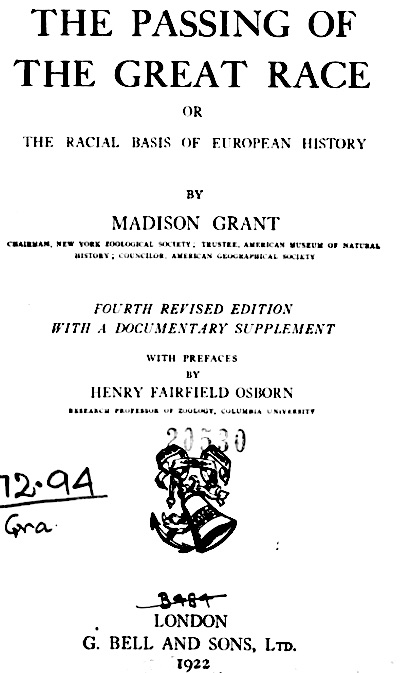
New ed., rev. and
Amplified, with a New Preface by Henry Fairfield Osborn. New York:
Charles Scribner's Sons, 1918
Rev. ed., with a Documentary Supplement, and a Preface by Henry
Fairfield Osborn. New York: Charles Scribner's Sons, 1921.
Fourth rev. ed., with a Documentary Supplement, and a Preface by Henry
Fairfield Osborn. New York: Charles Scribner's Sons, 1936.
Saving the Redwoods; an Account of the Movement During 1919 to Preserve
the Redwoods of California. New York: Zoological Society, 1919.[27]
Early History of Glacier National Park, Montana. Washington: Govt.
print. off., 1919.
The Conquest of a Continent; or, The Expansion of Races in America,
Charles Scribner's Sons, 1933.
引用文献
"The Depletion of
American Forests", Century Magazine, Vol. XLVIII, No. 1, May 1894.
"The Vanishing Moose, and their Extermination in the Adirondacks",
Century Magazine, Vol. XLVII, 1894.
"A Canadian Moose Hunt". In: Theodore Roosevelt (ed.), Hunting in Many
Lands. New York: Forest and Stream Publishing Company, 1895.
"The Future of Our Fauna", Zoological Society Bulletin, No. 34, June
1909.
"History of the Zoological Society", Zoological Society Bulletin,
Decennial Number, No. 37, January 1910.
"Condition of Wild Life in Alaska". In: Hunting at High Altitudes. New
York: Harper & Brothers, Publishers, 1913.
"Wild Life Protection", Zoological Society Bulletin, Vol. XIX, No. 1,
January 1916.
"The Passing of the Great Race", Geographical Review, Vol. 2, No. 5,
Nov., 1916.
"The Physical Basis of Race", Journal of the National Institute of
Social Sciences, Vol. III, January 1917.
"Discussion of Article on Democracy and Heredity", The Journal of
Heredity, Vol. X, No. 4, April, 1919.
"Restriction of Immigration: Racial Aspects", Journal of the National
Institute of Social Sciences, Vol. VII, August 1921.
"Racial Transformation of America", The North American Review, March
1924.
"America for the Americans", The Forum, September 1925.
+++
【引用文献】※自動番号づけなのでずれるかもしれな
い(要改良:正しい番号の画像:Madison_Grant_ref.jpg)
◎北方人種理論(=北欧人種優位説)Nordic theory (Nordic race)
北方人種理論の嚆矢は、ジョゼフ・ドゥニケール (Joseph Deniker)に遡れる。ジョゼフ・ドゥニケール(Joseph Deniker 1952-1918)はロシア生まれのフランスの博物学者、人類学者.ロシア南部のアストラハンにフランス人の両親のもとに生まれた。サンクトペテルブル クの大学、工科研究所で学び、エンジニアとなった。コーカサスの石油地域や中部ヨーロッパ、イタリア、ダルマチアを旅した。フランスに移住して、ソルボン ヌ大学で学び、1886年に自然科学の学位を得て、1888年にパリ自然史博物館の司書主任に就任した。『世界地理事典』(Dictionnaire de geographie universelle)の執筆者の一人で、人類学や動物学の学術雑誌に多くの論文を寄稿した。1904年にイギリスの王立人類学研究所に招かれ、ハクス リー記念講師職を受けた。人類学のドゥニケールの主著は『地球の人種と民族』("Les races et les peuples de la terre")である。ドゥニケールの作成したヨーロッパの人種地図は20以上に上る人種に分類したもので、当時多くの研究に引用された。ヨーロッパにお ける主要な人種が何種類あるかについて、ウィリアム・Z・リプレー(William Z. Ripley)らと論争した。ドゥニケールの人種の分類では、ヨーロッパの主要な人種を「北方人種(Nordic race)」「地中海人 種」「東洋人種(Oriental)」、「ディナール人種」、「イベリア人種(Ibero-Insular)」、 「アルプス人種」(Nordic、Littoral、Oriental、Adriatic 、Ibero-Insular、Occidental)」に分けることを提案した。さらにサブタイプとして、Sub-Nordic、North- Occidental、Vistulian、Sub-Adriaticを提案した。北方人種には、ゲルマン人種、スラブ人種、バルト人種、および主にバル ト・フィン諸語を話者とするフィン・ウゴル人種が含まれる。
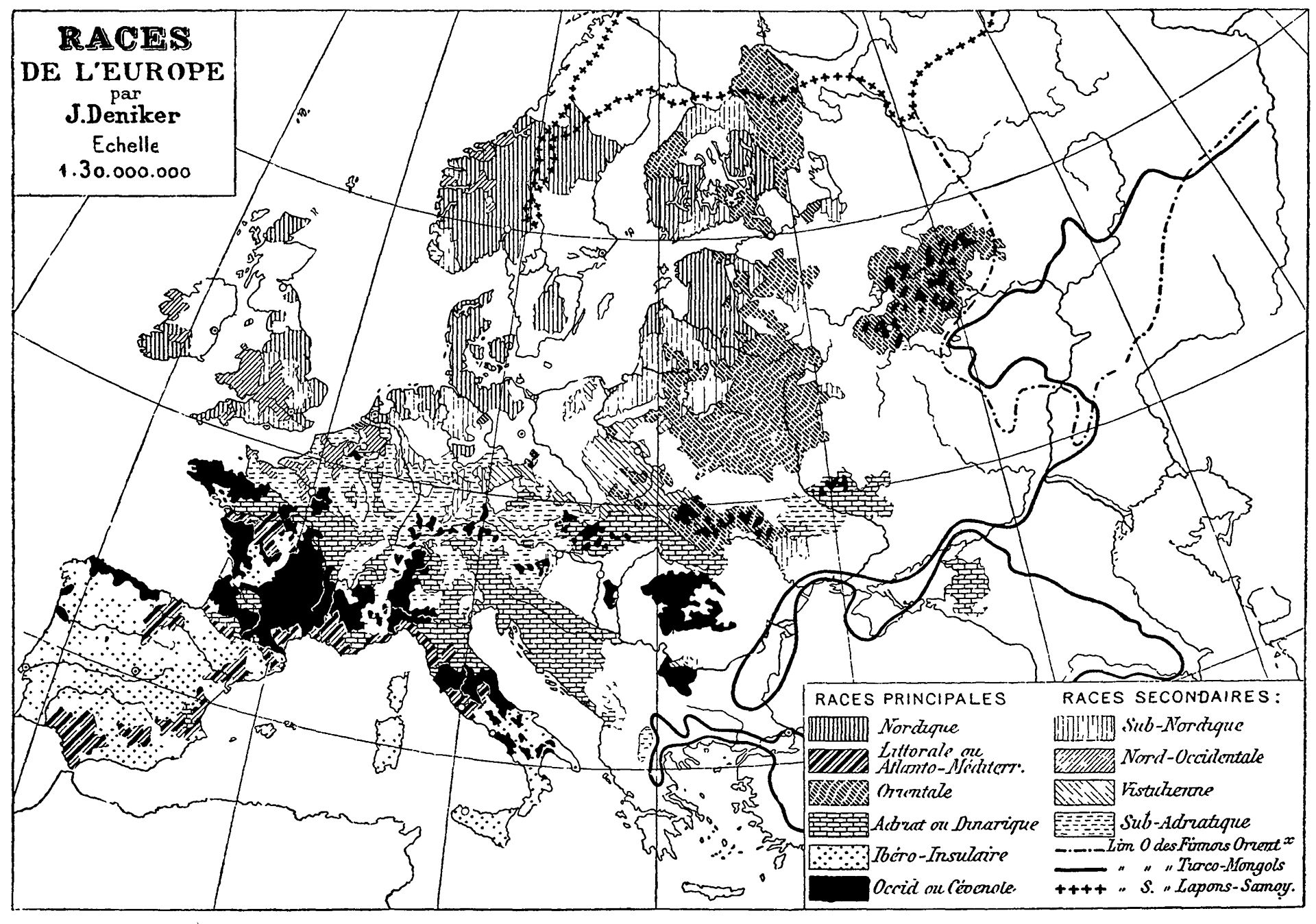
Deniker's "Races de
l'Europe" from 1899, listing as "principal races": Nordic, Littoral,
Oriental, Dinaric, Iberic, Occidental and as "secondary races":
Subnordic, Nord-Occidental, Vistulian, Subadriatic. Towards the north
and east, boundaries to the territory settled by non-European races are
shown: the Sami (Lap) (north), Eastern Finns (east) and Turco-Mongols
(east and south-east)
そのなかに、戦前から戦後まで活躍した人類学者ア ンリ・ヴァロア(Henri-Victor VALLOIS, 1889-1981)[1889-1981]がいる。ヴァロアは、自然人類学者のレオンス・マニュヴリエ(Leonce MANOUVRIER)[1850-1927]やマルセラン・ブール(Marcellin BOULE)[1861-1942]に薫陶を受け、1938年に(パリにある)人類学研究所教授、1941年には国立自然史博物館の民族学・人類学部門長 で、1960年まで務める。(出典:「ア ンリ・ヴァロア」)。ア ンリ・ヴァロアの写真の右は今村 豊と島 五郎「種族差の信用度」人類学雑誌、 48 巻 5 号 p. 237-260、1933年より。

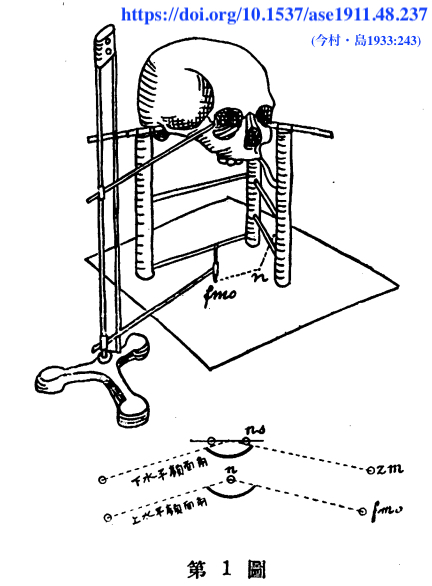
◎「白人の人種的衰退陰謀論/白人虐殺陰謀論」(White genocide conspiracy theory)の源流としての「ナチの優生学」

Eugenics poster at the
exhibition Wonders of Life in Berlin in 1935 showing demographic
projections under the assumption of higher fertility of the "inferior"
(Minderwertige) relative to the "superior" (Höherwertige).
Links
リンク
文献
その他の情報



++
Copyleft,
CC, Mitzub'ixi Quq Chi'j, 1996-2099